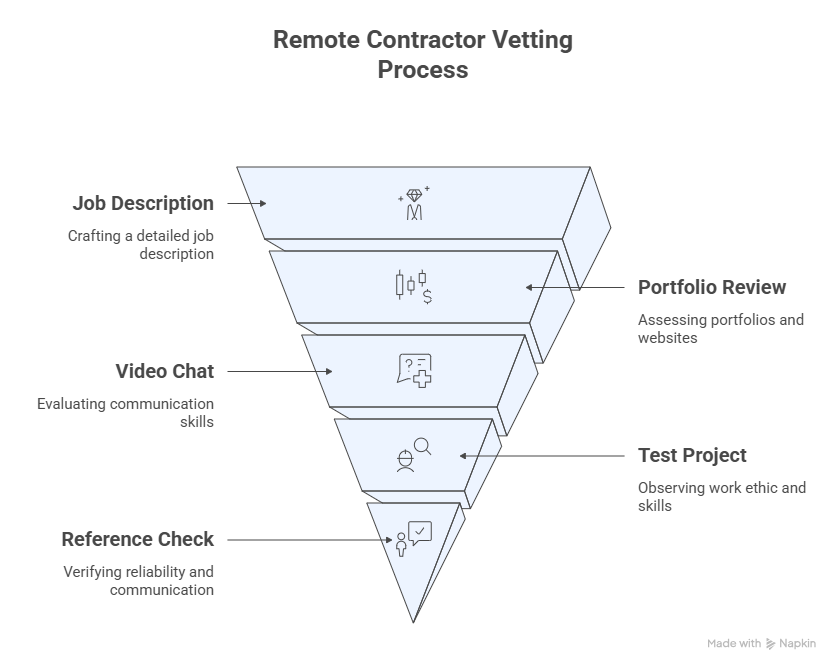As we’ve always said, the benefits of hiring a contractor in another country are numerous. You get access to top talent anywhere in the world, flexibility in how you scale, and often lower costs than hiring locally.
But it’s not as simple as finding someone online and sending them work. There are legal rules to follow, taxes to think about, and relationships to manage across time zones.
In this guide, we will walk you through the entire process, step by step. Our goal is to help you learn how to plan, hire, pay, and manage international contractors without headaches or costly mistakes.
1. Start with a Clear Plan
Like most things in life, planning is the first best step to hiring a contractor in another country. Before you start searching, take a step back and get clear about what you need. Ask yourself these three questions:
- What exactly will a remote contractor be doing for me or my organization?
- Is this project-based or an ongoing need?
- Do I need someone full-time or just a few hours per week?
These questions help you decide whether a contractor is the right fit. Independent contractors make sense when you need someone flexible, specialized, and not integrated into your daily operations like an employee would be.
If you expect fixed hours, tight supervision, or exclusive loyalty, then you might actually need an employee, not a contractor. Misclassifying someone could lead to penalties, so it’s important to be honest about the role from the start.
2. Find and Vet the Right People
Once you know what you’re looking for, it’s time to source candidates. There are plenty of platforms that connect you with global talent.
For general roles, sites like Upwork, Fiverr, or Toptal are great. You can try Arc.dev or Gun.io for developers, Dribble or Behance for designers, and also LinkedIn for lots of job roles.
When you start talking to candidates, don’t just look at their resumes. Review their portfolio, talk through their past work. You can also give them a small, paid test project to start . This shows you how they actually work and how they communicate, which often matters as much as skill.

3. Get Legal and Tax Compliance Right
This is where many businesses stumble. Hiring across borders means you need to make sure you’re following the rules in your country and in the contractor’s country.
For U.S. businesses, you’ll need to collect a W-8BEN form (or W-8BEN-E for businesses) to confirm the contractor isn’t a U.S. taxpayer. Keep good records of your payments, and talk to a tax advisor if you’re unsure about reporting requirements.
Also, make sure the person you’re hiring is legally set up as an independent contractor in their country. Some places have strict rules about what counts as freelance work, and ignoring them could expose you to fines or disputes.
If you’re unsure, services like Arbonum can handle the compliance side for you.
4. Write a Strong Contract and Set Up Payments
Your contract protects both you and the contractor. It doesn’t have to be filled with heavy legal jargon, but it does need to cover the basics:
- What work will be done and by when
- How and when you’ll pay
- Who owns the work (make sure intellectual property transfers to you)
- Confidentiality terms, if you’re sharing sensitive information
- How either side can end the agreement
- What happens if there’s a dispute
For payments, stick to platforms that are secure and cost-effective. Wise and Payoneer are popular for direct transfers. Arbonum is great if you want compliance support built into international payments, all-in-one. PayPal works in most countries but tends to have higher fees.
5. Onboard and Manage Effectively
Once your contract is signed, take the time to onboard your contractor properly. Share project details, introduce them to key people, and set them up on the tools you use, whether that’s Slack, Zoom, or a project management app like Trello or ClickUp.
Managing international contractors requires a bit of flexibility. Time zones will always be a factor, so focus on results instead of hours worked. Tools like World Time Buddy can help you find overlap for real-time meetings, and asynchronous updates, like recorded Loom videos, can keep things moving when you can’t meet live.
Check in regularly, not just to monitor work but to build rapport. Contractors who feel connected to your team are more likely to stay engaged and deliver their best.
6. Use the Right Tools
The right tech stack makes this process smooth. Here are some essentials:
- Communication: Slack or Microsoft Teams for chat, Zoom or Google Meet for calls.
- Project Management: Asana, ClickUp, or Trello for keeping tasks organized.
- Knowledge Sharing: Notion or Confluence for SOPs and project briefs.
- Payments and Compliance: Deel, Remote.com, Wise, or Payoneer.
Optional tools like Hubstaff or Time Doctor can track time if needed, but in most cases, focusing on outcomes is a better approach.
7. Build Long-Term Relationships
A great contractor relationship can last years and deliver incredible value, that is if you invest in it.
Give feedback often, acknowledge good work, and consider bonuses or contract extensions for consistent performance. Include them in team meetings or updates so they feel part of the bigger picture. Contractors who feel valued often become your most loyal and reliable partners.
Final Thoughts
Hiring international contractors isn’t just a way to cut costs. Done right, it’s a strategy for bringing world-class talent into your business without borders.
With this approach, you can build a global team that delivers high-quality work while keeping your operations flexible and efficient.




